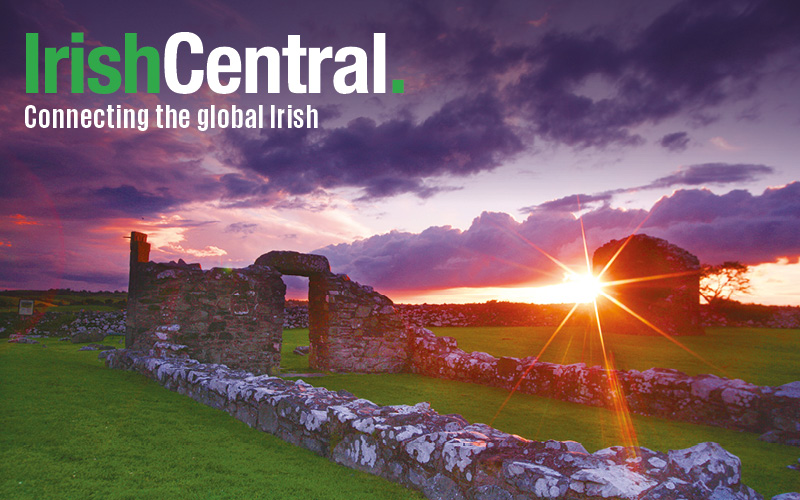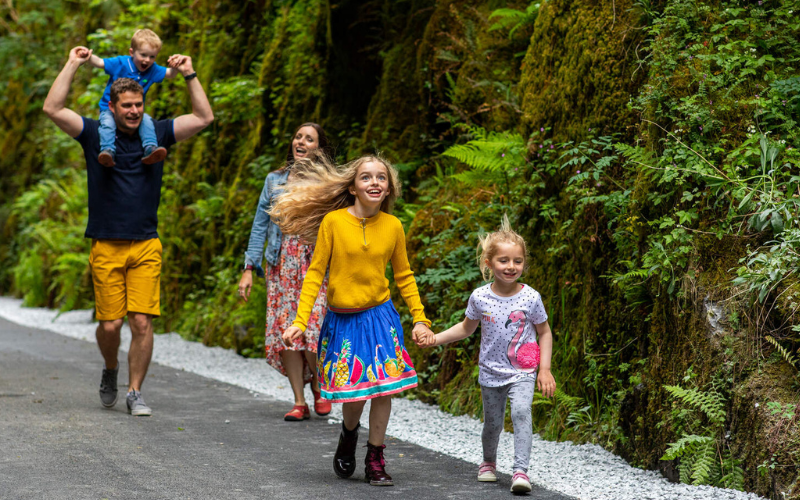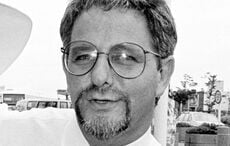Every adventure sets out to answer a question. It might be, “Can I?” or “Should we?” or “What if?” In my case, my endeavor to walk and golf the whole of Ireland began and ended with one particular question, an inquiry I bumped into almost every step of the way:
“Yer doin’ what?”
It was a question with another question quick on its heels: “Really – yer doing what?” often followed by, “Why in the hell are you doing that?” to the point where my four-month adventure in Ireland became a search for a satisfying solution to this last, and most relevant inquiry.
After 1,000 seaside golf holes, 1,100 miles on the hoof, and 320 pages, I hope that I have pieced together a proper answer. And perhaps some of the following will help explain why anyone would mistake Ireland for the world’s greatest round of golf, leaving his wife at home for a summer, and setting out from the Shannon airport with ten clubs on his back, and ten pages worth of tee times. My plan was to go and figure out why so many felt as passionately as I did about the golf being played along the coastline of Ireland, and to understand how golf had become the thing that had reconnected so many people of Irish descent with the home of their grandparents. I found Ireland to be a place that revels in its ironies, and none more so than the fact that a game brought to Ireland by an occupying army is now the pastime that brings so many thousands to its shores, a game that Ireland now does as well as (and for my euros, better than) any golf destination in the world.
A country the size of Indiana possesses some 40% of the true links courses on the planet (a links is a course built on sandy dune soil, designed by the wind, and perhaps the truest – or certainly, the original – expression of the game). It’s an astounding statistic (by strictest definition, there are no true links in the United States), one that should be celebrated as a tremendous source of Irish pride, and one that certainly seemed to require some investigation.
It was a golf map of Ireland, its outer edges ringed with golf holes, that first had me contemplating a round of golf that would truly go around, the ultimate game of golf played across a course called Ireland. But as I chased my disloyal golf balls around the dunes of Ireland, those golf holes became the least important characters in this journey. The people, the pubs, the roads, the history, the friends, the chippers, the sea cliffs, the gossip, the Gaelic, the caddies, the travelers – hell, even the dogs – all quickly became the easy answer to that question of why.
There was one other question that I heard in the clubhouses and on the roadsides as I made my way, a question I felt less equipped to answer: “Are you (bleeping) mad?” Some days, it felt that way. But on most days, like these days here, I just felt like the luckiest golfer, husband, tourist, and distant son of Ireland in the whole damn world.
One hundred and fifty years ago, a dozen young men and women set out from towns in the west of Ireland, traveling by cart and by foot, headed for ports in Ballina and Westport, County Mayo. They bundled up their lives and stepped onto crowded ships pointed toward a place they had never seen before. One of those young women carried with her a mahogany cupboard with delicate glass doors, flowers hand-carved into the panels. Today it hangs in my parents’ living room, next to a fifty-two-inch flat-screen television.
The names of those people, why they came, or precisely where they came from, had been lost in my family’s shuffle. It had been my experience that the one thing Irish families did better than talk was whisper, and generations of whispers – who was unlucky and who was ungrateful, who drank too much, died too young, who was a good daughter, a lazy son, who never married and, more quietly now, why not – blended into a collective hush. I found myself looking at that cupboard from time to time, covered with the next generations’ macaroni Christmas ornaments, a ceramic teddy bear, last month’s Mother’s Day cards. There was a golf ball in one of the nooks, a Titleist with a purple-and-red logo on it and the letters BGC: Ballybunion Golf Club. That cupboard came to America in the arms of a woman trying to put Ireland behind her, and now it hung on the wall showcasing a golf ball from County Kerry, reminding some of us how much we wanted to go back. And as I stood on my first tee box in the southwest of Ireland, looking out over golden dunes and black cliffs holding back a frothy sea, I felt certain that over the next 119 days spent walking the longest possible path to Ballybunion, I was going to figure out which one of us had it right.
My friend Denis had children my age, but we’d become good friends over the years as semi-regular golf partners – he divorced, me self-employed, we had high golf availability in common and found ourselves sharing a cart on many a Tuesday afternoon. And over those many Tuesdays, I came to understand that Denis dearly loved two things in the world – golf and Ireland (and his kids, I’m sure, but that wasn’t really relevant during twilight golf). For golf in Ireland, his availability was extreme – grandson of immigrants, he even had an Irish passport. He was packed for the trip before I even got around to inviting him, booking a spot during my first week, a stretch that promised more links than most.
It was widely known among golfing circles in southeastern Pennsylvania that Denis was a golfer who could come up short from almost anywhere on the golf course. We called him Captain Layup. Facing a carry over a lake, a pitch to the green, or a six-footer to the hole, rest assured that Denis had worked out some way in his subconscious to keep his ball from getting there. It wasn’t that he couldn’t hit it; rather, Denis was perpetually ready for that once-in-a-century five-iron that was going to travel a three-wood’s distance. But if it was going to happen this century for Denis, I hoped that it would happen here, on our first hole of the Irish golf course, a 373-yard par-four on a sleepy little seaside course called Kilkee.
Elder linksman of the group, Denis was granted the honor. Standing on the first tee, looking out over the Atlantic ocean where the water was torn white against the charcoal rocks, Denis stood tall on the tee box and breathed it all in. Pepper-haired with age in his eyes, that day he was a young boy staring into the sea, looking over this land he loved. He placed his three-wood behind his ball with reverence, took one long contemplative pause, and brought his club back, ready to make his golfing mark on one of this planet’s most historic bits of rock.
He paused at the top of his backswing, eyes bright with hope – we braced ourselves, waiting for the cannon blasts, the trumpets, the eruption from the gallery. But all we heard was a loud “FORE!” from the window of a passing pickup truck. The yell had been launched at Denis with perfect mid-backswing timing. The rest of his swing looked like he was trying to fend off a swarm of bees, Denis fumbling into his golf ball and knuckling a heel shot into the very nearby weeds.
I had traveled far from home and my head still wasn’t sure if this was sunrise or sunset golf we were playing, but as I watched Denis curse himself in Kilkee, the rest of our foursome choking back belly laughs, I felt a warm familiarity come over me. The drive-by-backswing-golf-shout was a street-side tee-box classic. And Kilkee or Philadelphia or wherever I might find myself tomorrow, it still played funny everywhere.
I tried to pretend not to see it, but it was unavoidable, directly out the front door from the B&B, a sign that I couldn’t miss.
“BALLYHEIGUE CASTLE GOLF CLUB”
I had planned on playing an Irish golf course that was 720 holes long. By the time I got on the plane in two days time, I would have played 981. What was nine more? And Ballyheigue to Ballybunion was a fair way to finish, I decided, golf on two remote ends of the Irish spectrum – from the town nine-holer to a course that made me wish I’d packed pants without cargo pockets (if noticed in Ballybunion, I had a Swiss Army knife ready to make them disappear). I put my last pair of wet, woolly socks over my sandy feet, grabbed my sack of sticks that had just barely survived the ocean an hour before, and headed for the clubhouse.
The course would have been more accurately described as the “LAST REMAINING BIT OF BALLYHEIGUE CASTLE GOLF COURSE,” because the castle was burned down by the IRA during the War of Independence, and what remained was its facade and a few turrets, sort of a backlot Hollywood castle with nothing behind the windows. It was an adolescent nine-holer (born in 1996) and far from a true links – half the holes were treeless, and from its hillside location overlooking the water, it had a seaside feel, a fair community course with views through an old castle wall to the beach and Ballyheigue Bay. It might blossom into something more substantial, but as it was, Ballyheigue was a safe setting for kids on holiday to knock it around. And lucky for me, that’s what I found as I dragged myself up to the first tee, three lads having just teed off ahead of me. They were each pulling golf bags bigger than they were and walking circles in the rough, looking like they had lost their mothers in the mall.
I took my time and played two balls, trying not to push the threesome, but on the fifth I wandered to the tee box and found a young boy sitting on a bench. He was wearing a soccer jersey and had short brown hair and a pale, freckled face. He couldn’t have been ten years old, and there was no chance that he weighed more than my backpack.
“Do you want to play along?” he said, sounding confident. “It’s slow today.”
I had been used to getting waved through as a single, and was always disappointed when I wasn’t asked to join a group – no matter if it was little old ladies or a pack of club-throwers, it was nice to be asked. His name was Eamon, and after watching their struggles over the opening holes, I was surprised to be asked to join up, but if he wasn’t too shy to shank it in front of a stranger, neither was I.
I thanked him and headed for the back tee box, past where two lads were returning from the regular tee, headed for Eamon’s bench. They were a couple years older, maybe twelve, both of them as skinny as six-irons, a kid named Colin in a Cork jersey and football shorts, and Eamon’s brother Declan dressed in a collared shirt and spikes, the golfer of the group.
“You’re teeing off from the blues,” Declan noted. “What do you play off?”
“I don’t know. Five, six maybe.”
“Five handicap. Did you hear that, Eamon!” Declan announced. They hurried off the tee box and took spots behind the bench, eager spectators. I eyed the fairway of a bending par-four as the gallery carried on.
“I never played with a 5 handicap.”
“Me neither.”
“What’s yer handicap?”
“I dunno. Maybe 20.”
“You’re a 20 handicap on one hole.”
“I am not.”
“You had a 12 back there. On a par-four.”
I hammered a booming cut down the right side of the fairway to a chorus of, “Whoa! See that? He hits it farther than your dad!”
“Where’d you get that driver?” Declan asked. “Can I have a look?”
I handed it over to him. “Colin, check it out,” he said, showing it off like it was Excalibur, turning the blue shaft in the sunlight. “Gorgeous. How much did it cost?”
“I don’t really remember,” I told him.
“Where are you from?”
“He’s from America, stupid.”
“But where in America?”
“We’ve been to Disney World…”
For five holes the questions came, and I answered them coyly with a smile, playing the reluctant celebrity for them. Declan had an off-balance but consistent swing, and Eamon somehow got the ball airborne with men’s clubs – he looked like he was swinging a javelin. Colin was the quiet one, pipe-cleaner legs sticking out of his white football shorts, he was struggling to keep it moving, and I could tell he was embarrassed.
“He’s a better player than this,” Declan whispered to me on the sixth.
“He’s been sick,” Eamon agreed. “He’s long off the tee. At least I think he’s long.”
“Eamon’s the putter,” Declan said of his little brother
"Love my putter. It’s about the only thing I’m good at. Declan can hit pretty much any shot.”
“I like to play,” Declan explained. “I practice a lot, too.”
I had been of the opinion that Ireland was a country overrun by its youngsters. It was an impression hard to shake after a summer bouncing from tourist town to tourist town, having to brave packs of chocolate-fingered preteens, dodging their ice creams and wasting hours of my life in line behind kids trying to figure if they could squeeze one more piece of licorice out of their fiver. Ireland was supposed to be an old place, wobbly canes and bushy white eyebrows, a drafty old house my grandparents spoke about as if it had been knocked down years ago. So where the hell did all these kids come from? And why were they always in front of me at the breakfast buffet?
When I was those boys’ age, I’d like to think I wouldn’t have, but playing with three other ten-year-olds, I would have likely laughed at my buddies’ whiffs, thrown tantrums when they in turn laughed at mine, and found a way to end the nine holes with one of us storming off the course with a face hot with tears, all friendships suspended for a minimum of twenty-five minutes. But these lads cheered each other around the course. They stuck up for one another, were quiet when they hit it sideways, told each other to give it another go because they could do it better than that. Golf took a lot of credit for teaching good manners, much of it undeserved – I had met as many cheaters and jackasses on the golf course as off. These boys had the respect their fathers showed for their friends, and that gave them a certain poise that I didn’t expect from kids, a species I had previously considered the original four-letter word. Ireland was a changing place, a younger place, and the lads were all right.
Declan showed me how he hit his bunker shots: “I’m pretty good in bunkers. I’ve got a sixty-degree wedge,” and from his little brother, “He’s got a sixty-degree wedge, do you have one? They’re amazing.” On the last, I let them each take a swing with my driver, even Colin, whose struggles had his head hanging. He politely told me no thank you, but I wouldn’t let him leave the ninth tee without getting up there in his sneakers and giving it a rip. I’d like to tell you he split the fairway, but he didn’t, knocking a dribbler onto the ladies’ tee. But at least he was laughing, and his friends were laughing, too.
His cheeks were red as he handed my driver back to me. “It’s a good club,” he said.
They had been around the nine holes three times that afternoon and had probably taken north of two hundred swipes each, but as we finished the final par-four in front of the stone facade of Ballyheigue, Colin looked down to the beach where the sun was still hanging above the ocean, and he guessed they had enough time to play nine more. So we said good-bye, and they kept going – they had plenty of excuses to quit, I was sure, Nintendos back in their beach caravans, and probably a half dozen blisters between them. They were stuck with hand-me-down sticks and bags big enough to take a nap in, but what did that matter when you were twelve and there was still light in the sky? I watched them tug their bags toward the first tee, sure they would be out there until dark. I used to play that kind of golf, and in Ireland or Philadelphia or anywhere, it was the best game I ever played.
Tom Coyne has written for Golf Magazine and Golfweek. He is the author of Paper Tiger and the novel A Gentleman’s Game, and is currently working on another book: 26.1 to Go – The Quest to Solve the Greatest Mystery in Sports: Where is Everybody Running To? coming out in 2011. He lives in Philadelphia with his wife Allyson and daughter Maggie.




Comments